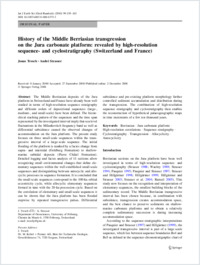History of the Middle Berriasian transgression on the Jura carbonate platform : revealed by high-resolution sequence- and cyclostratigraphy (Switzerland and France)
- Tresch, Jonas Department of Geosciences, University of Fribourg, Chemin du Musée 6, 1700 Fribourg, Switzerland - Dr. M. Kobel + Partner AG, Büro für Technische Geologie, Sargans, Switzerland
- Strasser, André Department of Geosciences, University of Fribourg, Chemin du Musée 6, 1700 Fribourg, Switzerland
-
02.12.2008
Published in:
- International Journal of Earth Sciences. - 2010, vol. 99, no. 1, p. 139-163
Berriasian
Jura carbonate platform
High-resolution correlations
Sequence stratigraphy
Cyclostratigraphy
Transgression
Allocyclicity
Autocyclicity
English
The Middle Berriasian deposits of the Jura platform in Switzerland and France have already been well studied in terms of high-resolution sequence stratigraphy and different orders of depositional sequences (large-, medium-, and small-scale) have been defined. The hierarchical stacking pattern of the sequences and the time span represented by the investigated interval imply that sea-level fluctuations in the Milankovitch frequency band as well as differential subsidence caused the observed changes of accommodation on the Jura platform. The present study focuses on three small-scale sequences within the transgressive interval of a large-scale sequence. The initial flooding of the platform is marked by a facies change from supra- and intertidal (Goldberg Formation) to shallow-marine subtidal deposits (Pierre Châtel Formation). Detailed logging and facies analysis of 11 sections allow recognizing small environmental changes that define elementary sequences within the well- established small-scale sequences and distinguishing between autocyclic and allocyclic processes in sequence formation. It is concluded that the small-scale sequences correspond to the 100-ka orbital eccentricity cycle, while allocyclic elementary sequences formed in tune with the 20-ka precession cycle. Based on the correlation of elementary and small-scale sequences it can be shown that the Jura platform has been flooded stepwise by repeated transgressive pulses. Differential subsidence and pre-existing platform morphology further controlled sediment accumulation and distribution during the transgression. The combination of high- resolution sequence stratigraphy and cyclostratigraphy then enables the reconstruction of hypothetical palaeogeographic maps in time increments of a few ten thousand years.
- Faculty
- Faculté des sciences et de médecine
- Department
- Département de Géosciences
- Language
-
- English
- Classification
- Palaeontology
- License
-
License undefined
- Identifiers
-
- RERO DOC 17409
- DOI 10.1007/s00531-008-0375-3
- Persistent URL
- https://folia.unifr.ch/unifr/documents/301500
Statistics
Document views: 139
File downloads:
- Document: 194
